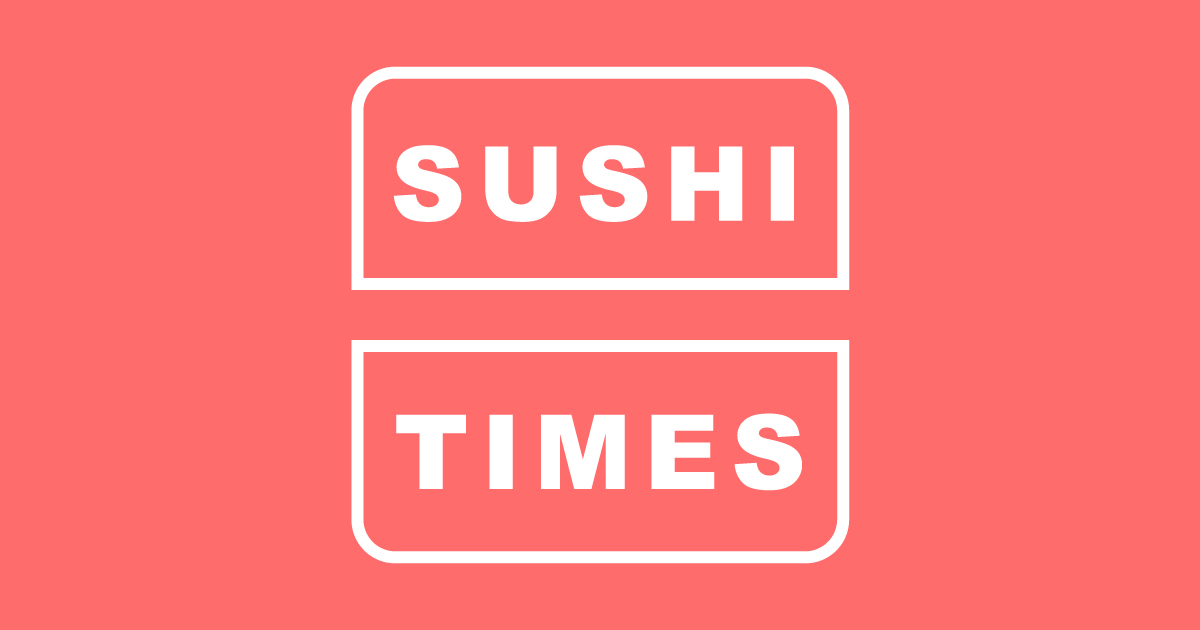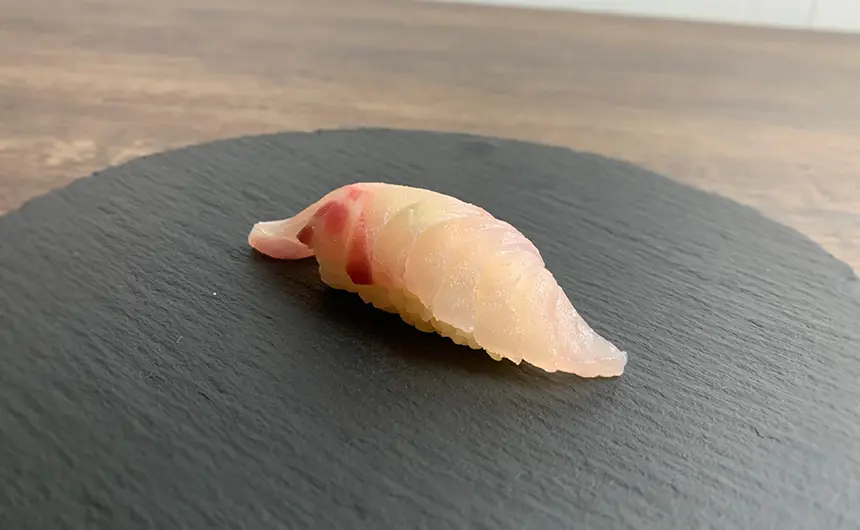「土用の丑の日」豆知識 All About the Japanese Summer Tradition of Eating Eel to Power through the Summer
日本独特の夏の風習のひとつに「土用の丑の日」があります。毎年、その時期を迎えると鰻を食べるというものですが、いったいどんな意味や由来があるのでしょうか?今回はその豆知識をご紹介します。
Doyo no Ushi no Hi is a uniquely Japanese summer tradition. Every year, people in Japan eat unagi (eel) at this time of year. What is the meaning of this practice? Here is some information about it.
夏の「土用の丑の日」っていつ? When Is Doyo no Ushi no Hi
毎年日にちは異なり、年に1度しかない年もありますが、2018年の夏の「土用の丑の日」であれば、「7月20日(金)」と「8月1日(水)」の2日が該当します。
Doyo no Ushi no Hi falls on a different day each year, and can be just once a year, but in 2018, it is Friday, July 20 and Wednesday, August 1.
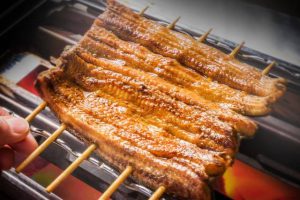
「土用の丑の日」の意味 The Meaning of Doyo no Ushi no Hi
そもそも「土用の丑の日」とは夏だけではなく、春・夏・秋・冬それぞれに存在するもの。まず「土用」という言葉は、四立と呼ばれる季節のはじまり「立春(2月4日頃)」・「立夏(5月5日頃)」・「立秋(8月7日頃)」・「立冬(11月7日頃)」の、それぞれ前約18日(または19日)の期間のことを指します。各季節の終わりの約18日間、つまり次の季節へ移る前の調整期間のようなものです。
さらに、「丑の日」とは、年・方角・月・日にちを数えるときに使われる「十二支」のなかの「丑」のことで、12日周期で巡ってくる「丑の日」、つまり約18日間の「土用」の期間のうち、12日周期で割り当てられている十二支が「丑の日」に該当する日が、 「土用の丑の日」となるのです。
Doyo no Ushi no Hi actually exists not just in the summer, but in the spring, fall and winter as well. Doyo refers to the period of about 18 or 19 days before the beginning of each season, known as shiryu, which is around February 4 in the spring (Risshun), May 5 in the summer (Rikka), August 7 in the fall (Risshu), and November 7 in the winter (Ritto). It is essentially around 18 days at the end of each season, almost like an adjustment period before entering the next season.
Ushi no Hi is the day of the Ushi (Ox) of the Chinese zodiac used to measure years, directions, months and days, and comes around every twelve days. So Doyo no Ushi no Hi is the day of the Ox that comes around every twelve days within the 18-day Doyo period.
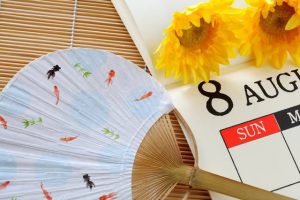
なぜ夏の「土用の丑の日」に鰻を食べるの? Why Eat Unagi on Doyo no Ushi no Hi?
夏の土用は、1年の中で最も暑さが厳しいとされる時期。江戸時代(1603〜1867年)には、「土用の丑の日」を重視し、この時期に薬草を入れたお風呂に入ったり、お灸をすえることで、夏バテや病気回復などに効き目があるとしていました。栄養たっぷりの鰻を食べるようになったのも同じ理由からです。
The summer Doyo is the period that is considered to be the hottest of the year. During the Edo Period (1603 – 1867), people paid great attention to Doyo no Ushi no Hi, and practiced various measures to prevent heat fatigue and to improve health, such as taking medicinal baths and burning moxa on the skin. The practice of eating nutritious unagi started for the same reason.
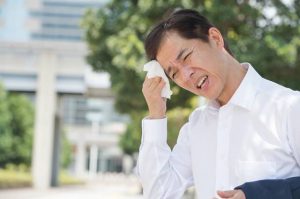
江戸時代の万能学者・平賀源内が仕掛け人?! Initiated by the Edo Period Renaissance Man, Hiraga Gennai?!
実はこの風習は、江戸時代(1603-1867年)の万能学者・発明家である有名な人物「平賀源内」が仕掛けたものという説があります。鰻の本来の旬は冬、源内の知り合いの鰻屋が夏には売れ行きが悪く困っていたところ、店頭に「本日、土用の丑の日、鰻(Unagi)の日」という内容の貼り紙をするよう発案したのだとか。これが大当たりして店は大繁盛!「丑の日(Ushinohi)にちなんで「う(U)」からはじまる名前の食べ物を食べると夏負けしない」 という言い伝えと相まって、夏の土用の丑の日に鰻を食べる風習が世の中に広まり、定着していったとされています。
There is a theory that this practice was initiated by Hiraga Gennai, who was a famous renaissance man of the Edo Period (1603-1867). Unagi is actually in season in the winter, so the story is that Hiraga came up with the idea of posting a sign that says “Today is Doyo no Ushi no Hi, the day for unagi” to help a friend who owned an unagi restaurant that was struggling with low sales in the summer. This became a big hit and the shop thrived. This, along with the belief that eating items that start with the same vowel as Ushi no Hi, such as unagi, gives one the strength to survive the summer, resulted in the birth of a tradition of eating unagi on Doyo no Ushi no Hi.
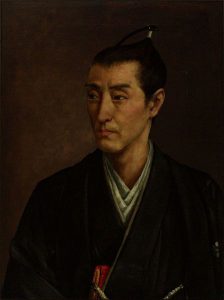
地方で焼き方が異なる!「鰻の蒲焼」の豆知識 Regional Differences in Unagi no Kabayaki
全国で愛されている「鰻の蒲焼」ですが、実は関東風と関西風で焼き方・仕込み方が異なることをご存じでしょうか?どちらもそれぞれに美味しいので、食べ比べてみるのも面白いかもしれません。
Unagi no Kabayaki (grilled filleted unagi) is enjoyed throughout the country, but did you know that they are prepared and grilled differently in the Kanto and Kansai regions? They are tasty either way, so try them both ways to find out which you prefer.
関東風 Kanto Style
一説には、江戸では侍が多かったことから鰻を腹部側から割くのは「切腹」を連想させるとされ、背側から割く「背開き」が浸透したと言われています。また、気が短いと言われる江戸っ子にすばやく提供できるようにと、鰻の身を炭火で焼いて(=白焼き)箱に入れて蒸らしておき、お客が来たらタレをつけて焼くという方法がとられたとも言われています。そのほか、焼くときに「竹串を使う」ことや、頭を落としてから焼くことも特徴です。
There is a theory that because there were many samurai in Edo (present day Tokyo), unagi were cut from the back so as not to remind them of seppuku by cutting the stomach. It is also said that because people from Edo tend not to be patient, it became common to chargrill the eel in advance and steam them in a box, so that they could be quickly grilled again with sauce when customers arrived. Kanto-style grilled eel is also distinguished by the fact that bamboo skewers are used to grill them and that the head is chopped off before grilling.
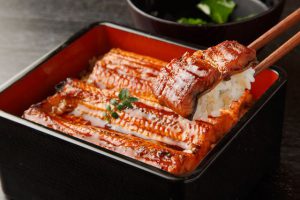
関西風 Kansai Style
江戸の侍文化に対し、関西は基本的に商人文化の町。商人同士「腹を割って話す」ということから腹開きになったという説があります。そのほか、焼きの技術でうなぎを柔らかくすることから「蒸さない」、焼くときに「金串を使う」、頭をつけたまま焼いて最後に落とすことも特徴です。
In contrast to the samurai culture of Edo, the Kansai Region was known for its merchant culture. It is said that unagi in the Kansai Region is cut open in the front, based on the expression often used by merchants “to talk with the stomach revealed”, which means to talk frankly. Kansai-style unagi is not steamed, and is made soft through grilling techniques. It is also grilled with stainless-steel skewers and with the head intact (which is cut off before serving).
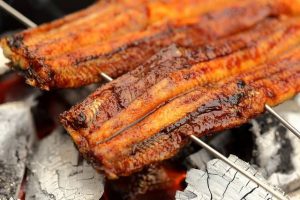
「土用の丑の日」に食べたい!おすすめ鰻専門店 Recommended Unagi Shops to Go to on Doyo no Ushi no Hi
それでは、実際に日本を訪れた際におすすめしたい全国の鰻専門店をご紹介したいと思います。今回は、主要都市である東京・大阪・京都のお店をピックアップしました。
We now introduce recommended unagi restaurants around the country. This time, we focus on restaurants in Tokyo, Osaka and Kyoto.
【東京】鰻 駒形 前川 東京スカイツリータウンソラマチ店 Tokyo – Maekawa TOKYO SKYTREE TOWN Solamachi Branch
創業200年以上という歴史ある老舗「鰻 駒形 前川」の東京スカイツリータウンソラマチ店。ふっくらと焼き上げられた心地よい舌触りと、伝統的に継ぎ足されてきたタレの旨味が口の中で溶け合います。メニューは多様にそろっていますが、おすすめの一例を挙げると「うな重(4,212円(税込))」などです。外国語メニュー(英語、中国語簡体字・繁体字)あり。
This is the TOKYO SKYTREE TOWN Solamachi branch of Maekawa, a famous unagi restaurant that was established more than 200 years ago. The soft and fluffy unagi has a wonderful texture and goes perfectly with the sauce that has been added to over the years. There is a wide selection of items on the menu, with one recommendation being the Unaju (4,212 JPY (incl. tax)), grilled unagi on rice. There are menus available in English, Simplified Chinese and Korean.
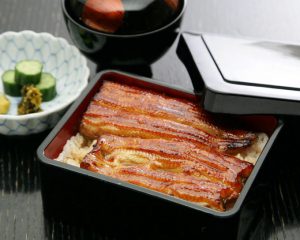
【大阪】大阪 うなぎ組 Osaka – UNAGI
国産の指定養殖場から厳選された上質の鰻を毎日朝引きにして使用している人気店。関西にありながら、白焼きにしてふんわり蒸し上げる「江戸前仕込み(関東風)」で、鰻の美味しさを堪能できます。メニューは色々なものがありますが、一例を挙げると、おすすめはディナーの「うな重御膳(2,808円〜4,536円(税込))」など。香ばしさと旨味を存分に味わえますよ。
This is a popular restaurant that serves high quality unagi from designated unagi farms in Japan, that are prepared fresh each morning. Although the restaurant is in the Kansai Region, it serves soft and fluffy Edo-style unagi, where you can enjoy the flavors of the fish that has been steamed and grilled. There is a wide selection of items on the menu, but one recommendation is the Unaju Gozen (2,808 JPY to 4,356 JPY (incl. tax)) that is available for dinner. This is a great set for enjoying the aroma and flavors of unagi.
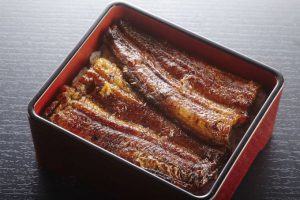
【京都】廣川 Kyoto – Hirokawa
「ミシュランガイド京都・大阪2018」にも掲載された実力派の有名店。京都屈指の景勝地・嵐山エリアにあり、1階からは美しい庭園を、2階予約席からは嵐山の展望を楽しみながら食事をすることができます。使われている鰻は上質で新鮮なものだけを吟味。来客に合わせて丁寧に仕込みがほどこされ、口のなかでとろけるようなふっくらとした食感に焼き上げられています。おすすめメニューは「上うな重(4,200円(税込))」などです。外国語メニュー(英語)あり、外国語対応可能なスタッフ(英語)がいます。
This is a famous restaurant that was featured in the 2018 MICHELIN Guide Kyoto – Osaka. It is in Arashiyama, which is one of Kyoto’s most scenic spots, and offers views of the garden from the first floor, and a panoramic view of Arashiyama from the second floor reserved seating. The unagi served here is high quality unagi that has been meticulously selected. it is prepared carefully for each guest and is grilled to a perfectly fluffy texture that seems to melt in the mouth. One recommended menu item is the Jo Unaju (4,200 JPY (incl. tax)). There are menus in English as well as staff who speak English.
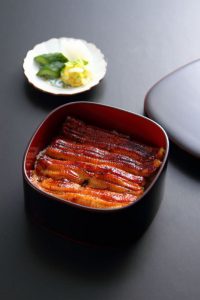
ぜひこの時期に日本を訪れるなら、美味しい鰻を食べて、暑い夏も元気に過ごしてくださいね!
If you are visiting Japan in the summer, be sure to have some unagi to power through the hot season.
※本記事の情報は執筆時または公開時のものであり、最新の情報とは異なる可能性がありますのでご注意ください。
*Please note that the information in this article is from the time of writing or publication and may differ from the latest information.
出典:WOW!JAPAN
